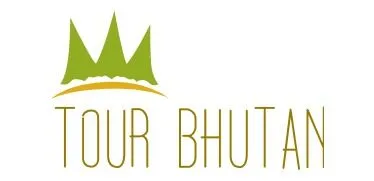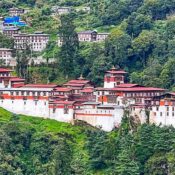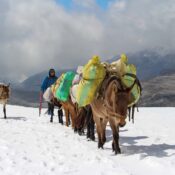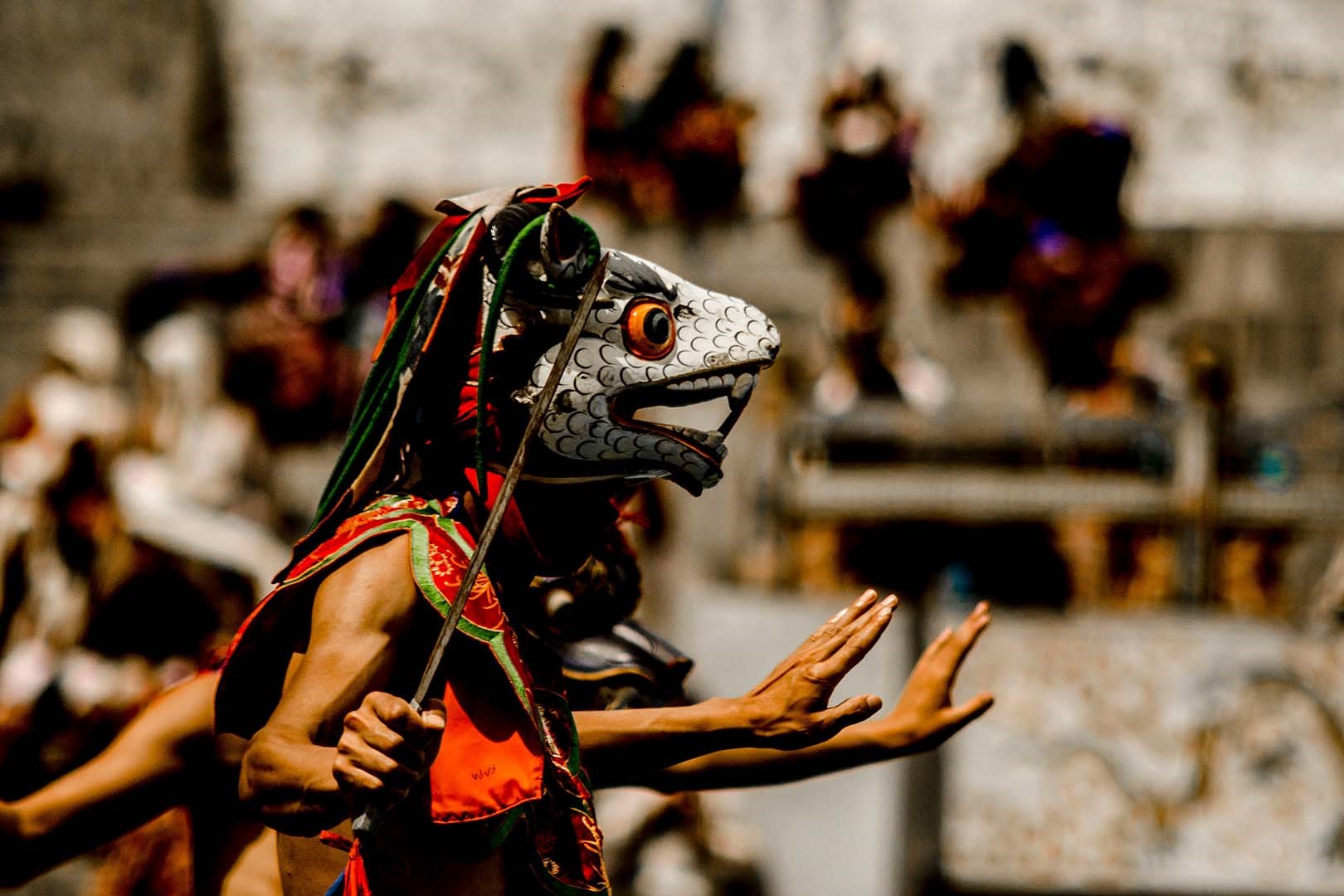Paro Rinpung Dzong

Paro Rinpung Dzong
Rinpung Dzong sometimes referred to as Paro Dzong, is a large dzong – Buddhist monastery and fortress – of the Drukpa Lineage of the Kagyu school in Paro District, Bhutan. It houses the district Monastic Body as well as the government administrative offices of Paro Dzongkhag.
Approached by a gently sloping flagstone road and an attractive wooden cantilever bridge roofed with shingles and abutted by two guard houses, the Dong is the administrative seat of the district of Paro. It also houses the state monastic community of about 200 monks.
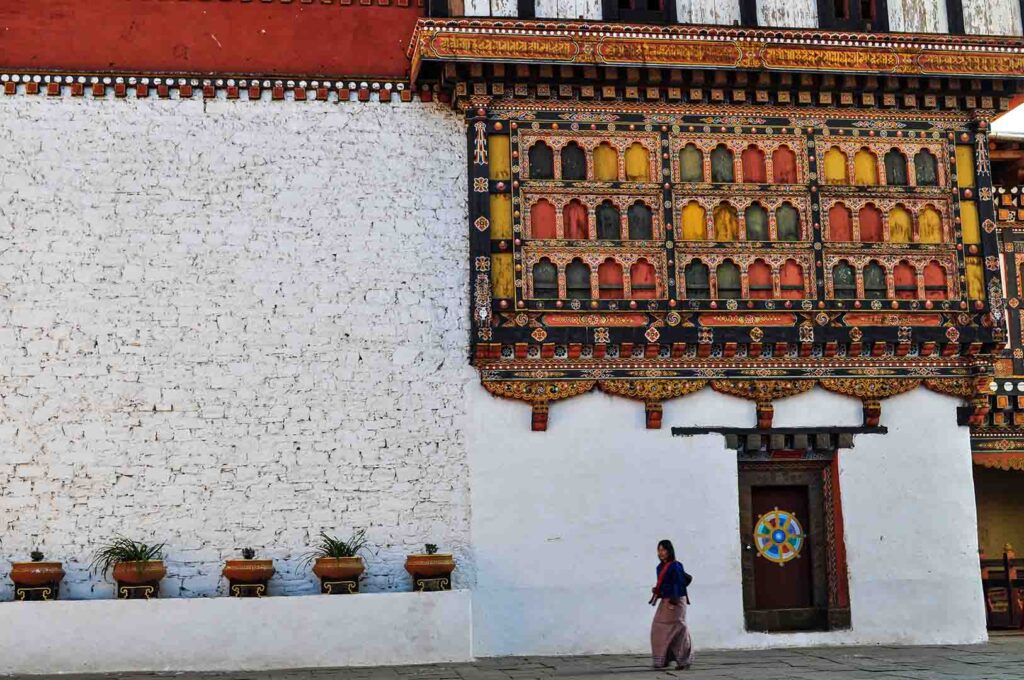
Paro Rinpung Dzong
History of Paro Dzong
The construction of the Paro Dzong began in 1644 on the order of Zhabdrung Ngawang Namgyal, the unifier of modern-day Bhutan. Unlike most of the other Dzongs in Bhutan, it survived the massive 1897 earthquake although it was damaged by fire in 1906.
Paro Dong’s full name is Ringpung Dzong, which means the fortress of the heap of jewels’. In the 15th century, two brothers – descendants of Phajo Drugom Zhigpo, the founder of the Drukpa Kagyupa School in Bhutan – named Gyelchok and Gyelzom lived in the Paro Valley. Gyelzom established himself at Gangtakha Monastery, while his brother Gyelchok travelled to Tibet to study theology. When Gyelchok came back to Paro, he was not respected in the community, as he had become a pauper. His brother Gyelzom renounced his existence; in his eyes a “beggar” could not be part of the family.
Gvelchok then moved to Humrelkha, a place that took its name from the guardian deity of Paro, Humrel Gyalpo.
He built a five-storied structure, which would later become the Paro Dzong, on a ridge above the Pa Chu River. It is said that at the base of the cliff was the La Tsho (soul lake) of the deity Jag Wog Nep. In 1644, Gyelchok, “the Lord of Humrel”, relinquished his small fort to Zhabdrung Ngawang Namgyel, thus recognizing his religious and political prowess. Immediately, the Zhabdrung began the construction of a much superior and more extensive fortress. The Dzong was consecrated by Zhabdrung Nawang Namgyal and Karma Rigzin Nyingpo, the reincarnation of Terteon Sangay Lingpa. La Ngonpa Tenzin Drugda was appointed as the first Penlop in 1646 and became the centre of a dual administration – both spiritual and temporal. The Penlop’s jurisdiction extended from Pharikha in the north and Dalikha in the west to Pag-samkha in the South. In 1906, during the time of the 23rd Penlop Dawa Penjor, the Dzong was burnt almost to the ground. All important relics and statues were lost to the fire and nothing could be salvaged except for the Thongdrol, a 20 × 20 metre-wide Thangka. It is displayed to the public during the annual Paro Tshechu. With money raised by a special tax levied throughout Bhutan, the Dzong was immediately rebuilt to the original design by the Paro Penlop Dawa Penior.
The master carpenters in the construction were Geden from Paro Shomo and Zochung from Paro Chang. The work was supervised by Zimpon Ri Thangpa Sigyal.
Structure and Facilities of Paro Dzong
Administrative offices line the first courtyard of the Dzong.
The entrance is guarded by two traditional paintings standing on either side of the gate: a Mongol holding a tiger on a leash and a man holding a black yak.
The five-storied utse of the Dzong is one of the most beautiful, with its outstanding woodwork. Its 4th floor has a temple dedicated to the line of Drukpa Kagyupa Lamas, a temple of the eight kinds of Chortens and a temple of Taras.
A statue of Guru Rinpoche, built by Sherab Wangchuk, is located in the 4th floor. The Goenkhang is located on the 3rd floor and houses statues of Mahakala and Mahakali. Next to it is the Terton Lhakhang, where the statue of Gonpo Man-ing, an emanation of Mahakala, resides.
Another exceptional feature of the Dzong is the small Lhakhang was built against the base of one of the eastern tower’s walls. This temple is dedicated to Chuchizhey, the eleven-headed god Avalokiteshvara, with his thousand arms and thousand eyes. The ceiling is adorned with nine beautiful mandalas. At the entrance of the Dzong is the Chador temple. In the Mithrugpa Lhakhang, the main statue is that of Lord Buddha and Zhabdrung, built by Sherab Wangchuk, the 10th Penlop. In the Dukhang is the Lord Buddha, built by Dawa Penjor.
The annual Paro Tshechu is held from the 9th to the 15th of the 2nd month every year. It was first introduced by Gy-alse Tenzin Rabgye in 1687. While the tshechu was initially held in the Dzong, after the reconstruction in 1906 it was held outside. The highlight of the tshechu is the Thongdol which is believed to deliver from all sins. The Thongdol that was saved from the fire of 1906 was built by Lama Nawang Rabgay and is considered one of the oldest in Bhutan. It was slightly renovated by the government about twenty years ago. The material for the Thongdol was brought from Lhasa in Tibet.
Highlight of Paro Rinpung Dzong
- Observe the architecture of the Dzongs
- Witness the excellent scenery.
Timing and Entrance Fees
Nu.1000 for tourists and no entrance fees for locals.
